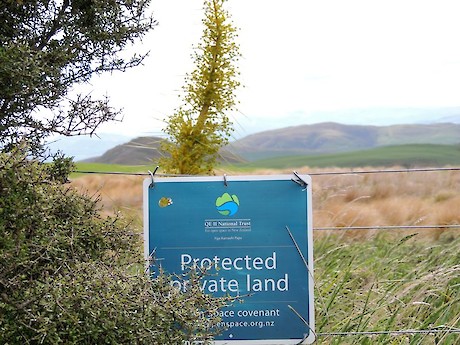 Covenanted red tussock wetland on a hill country farm. Photo: Jesse BythellProtecting biodiversity on private land has been the principal activity of the Queen Elizabeth II National Trust since it was established in 1977. As a result numerous habitats and features, including many not found on public conservation land, have been protected through the foresight and goodwill of private landowners.
Covenanted red tussock wetland on a hill country farm. Photo: Jesse BythellProtecting biodiversity on private land has been the principal activity of the Queen Elizabeth II National Trust since it was established in 1977. As a result numerous habitats and features, including many not found on public conservation land, have been protected through the foresight and goodwill of private landowners.
Approximately 70% (19 million hectares) of New Zealand) is privately owned with just over 16 million hectares being farmland. QEII provides a mechanism to protect natural features on private land. A particular strength is the ability to protect ecosystems or species which occur in the lowlands or on specific geology which may not be well represented in public conservation land. A good example of this is eastern South Island limestone communities which support a suite of endemic calcium loving plants and the majority of which occur on privately owned land.
Since 1977, more than 187,202 hectares has been protected by private landowners registering covenants over areas with the QEII National Trust. These covenants protect a variety of areas including forest remnants, wetlands, lakes, peat lakes, coastline, tussock grasslands, areas of rural landscapes, archaeological sites, geological formations and areas with high scenic value.
Open space covenants
An open space covenant is a legal agreement between QEII and a landowner to protect a special open space feature in perpetuity - it is entered into voluntarily by the landowner. The area for protection is spatially defined and a covenant is registered against the title of the property specifying the values to be protected and a set of actions which are prohited in order to maintain the stated values (e.g. not burning a forest or draining a wetland). Covenants ‘run with the title’ and therefore bind all future owners - by buying a property with a covenant on the title the new owner is automatically bound by the covenant agreement. QEII offers support with fencing areas off (if this is needed) and management of covenant areas, with specialist advice and monitoring. Field officers visit a covenant site at least every two years. There is a contestable fund covenant owners can apply to if they wish to undertake a conservation project in their covenant (e.g. pest control).
Each covenant is unique. It can apply to the whole property or just part of the property. There can be different management areas within a covenant with varying applicable conditions. Conditions can be stringent where rare or vulnerable natural features or habitats are being protected. Despite the constrains covenants represent they are very popular and on average there have been two new covenants registered somewhere in New Zealand since the QEII National Trust was formed.
